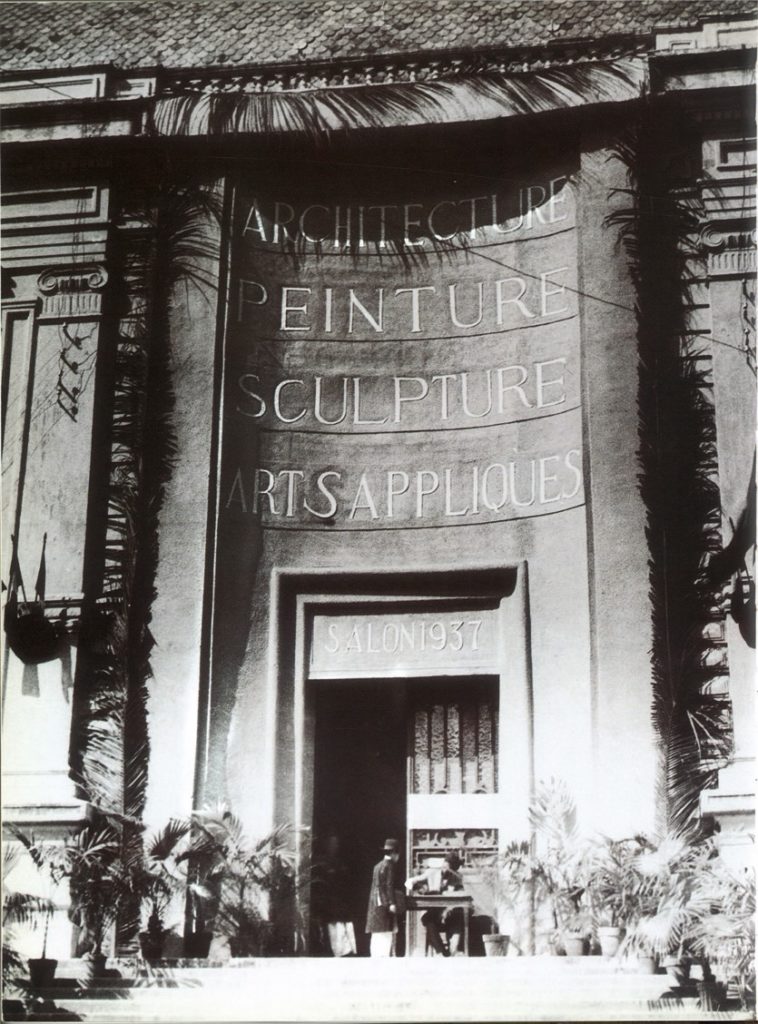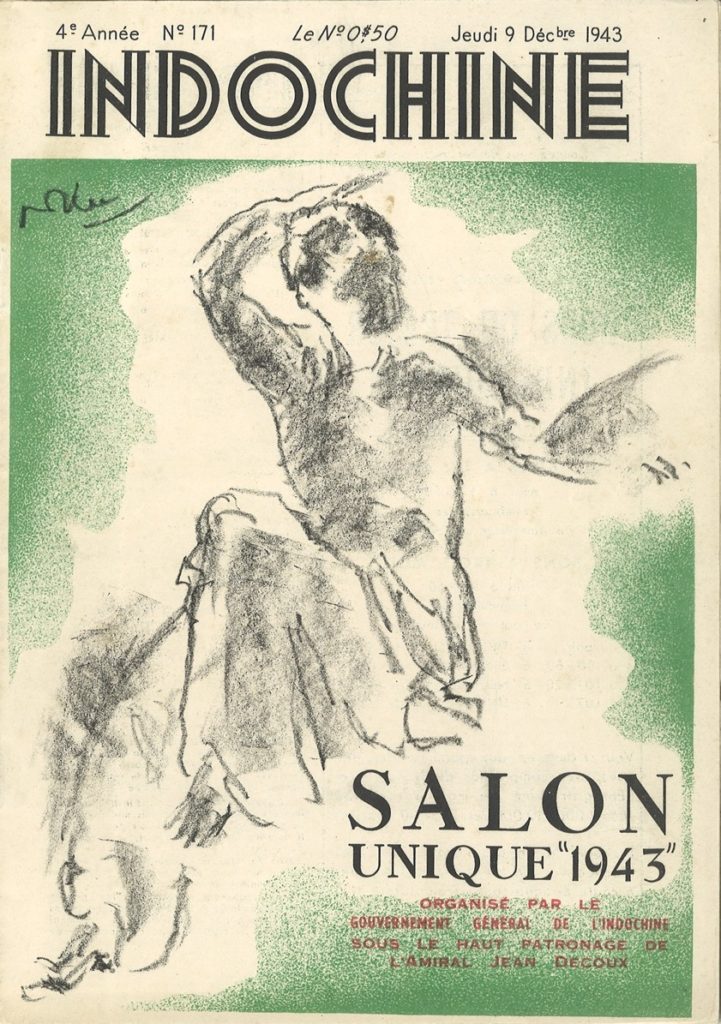SADEAI, FARTA, Salon Unique, AGINDO : Under the acronyms and words, a strong commitment to promote Vietnamese Painting and Sculpture
The “Indochina School of Fine Arts” organized exhibitions very early on to show the work of its students. It was created in October 27, 1924 in Hanoi by the French colonial administration and Victor Tardieu was its first director. The exhibition of November 1929 (photo below) exhibited students not yet graduated (the first class would have its laureates in 1930), but everyone of them was aware that a major exhibition was planned in Paris in 1931.

To exhibit is to be confronted with the gaze of an other and Hanoi in the 1930s and 1940s (until the Japanese coup of March 9, 1945) was the place, along with Paris essentially (but also Rome, Naples, Algiers, Oran and a few others…) where Vietnamese artists conquered their public.
Under abstruse acronyms lived strong projects expressing a fierce determination to promote, at various levels, a contemporary Vietnamese art.
SADEAI, Salon Unique, FARTA, AGINDO, acronyms and two words together, which did much for Vietnamese art.
- SADEAI is the abbreviation for the “Société Annamite d’Encouragement à l’Art et à l’Industrie“, created in Hanoi in May 1934. It was granted legal capacity by a decision of the Governor General dated August 6, 1935. Its head office was located at the School of Fine Arts, whose director was the President.
Organically linked to the School, it admitted as members other Vietnamese artists and craftsmen who were not graduates of the School. Its intention was to contribute to the development of arts and applied arts, decoration and industry in Indochina, to serve the interests of its members and to assist them in case of need. To this end, it organized competitions with the award of prizes and diplomas to the winners and sponsored works of artistic and cultural popularization.
Finally, it organized each year in Hanoi a fair including a section of painting, drawing and engraving, a section of sculpture and a section of decorative arts. Each of these sections had a different jury that ensured a rigorous selection of the works presented to the public. The best of these works were awarded by these same juries: plaques, gold, silver or bronze medal diplomas.
The first two exhibitions took place in February 1935 and December 1936. Almost all the painters who had graduated or were students at the Ecole des Beaux-Arts at the time, with the exception of To Ngoc Van who was in Phnom Penh at the time, participated. The painting section brought together nearly 200 oil paintings, gouaches and inks on silk, woodcuts and Indian ink drawings on paper. The public of Hanoi followed. The press was interested. The buyers of the works of art were… the colonial French…
The “Société Annamite d’Encouragement à l’Art et à l’Industrie” exerted a considerable influence on the artistic and craft production of Vietnam, prolonged the success of the 1931 Paris Colonial Exhibition, and accompanied that of the 1937 Universal Exhibition, also in Paris.
The photo below shows the majesty of the 1937 event:

The 4th and last exhibition of the SADEAI was organized in 1939. Victor Tardieu died on June 12, 1937 and was replaced as president, not by Évariste Jonchère, his soon to be contested successor, but by the architect Charles Lacollonge, who himself died in 1939. No more leaders, the war in Europe which was announced, the Japanese threat which is precise: the SADEAI withers…
This is how the SALON UNIQUE came to replace the obsolescence of the SADEAI: two very large exhibitions were held in Hanoi under the name of “Salon Unique”, organized by the General Government of Indochina, “under the patronage of Admiral Decoux”, at the AFIMA headquarters (see below) in 1943 and 1944.
On December 9, 1943, the magazine “Indochine” published by “L’association Alexandre de Rhodes” made the cover of its 171st issue with a charcoal drawing by Nguyen Tuong Lan and published some very interesting articles (notably by Claude Mahoudeau). In 1944, for the second and last Salon, “Indochine” entrusted its cover to Nguyen Gia Tri.

- FARTA is the abbreviation for the “Foyer de l’Art Annamite” founded in 1937 by To Ngoc Van, Tran Van Can, Luong Xuan Nhi, Nguyen Khang, Georges Khanh, and Le Van De, president. FARTA carried out its activities within the AFIMA (“Association pour la formation intellectuelle et morale des annamites”) created by Pham Quynh in 1919. François Guilleminot in “Vietnam, Fractures d’une nation. A Contemporary History from 1858 to the Present.” La Découverte ” Paris 2018 summarizes Pham Quynh’s desire (p81-82):
“The root of the problem is less political than cultural: the most serious danger is not so much the deprivation of independence as the loss of its soul or national essence. The country must borrow its science from the West while retaining its identity, preserving its ancestral culture.”
This affiliation to AFIMA, the political differences of its founding members, the independence in the interdependence of the advanced ideology, finally the vagueness of the project, will make FARTA an empty shell. It is not irrelevant to recall here that Pham Quynh was assassinated by the Vietninh on September 6, 1945…
- AGINDO is the abbreviation of the “Agence Économique de l’Indochine” founded in Paris under the aegis of Albert Sarraut in 1917. Financed by the Indochinese colonial budget, its aim was to “popularize Indochinese wealth in France”.
It was the appointment, in 1929, of Paul Blanchard de la Brosse – previously Governor of Cochinchina from 1926 to 1929 – as Director of the Agency that would instill in him a particular sensitivity to the works of the Hanoi School of Fine Arts: acting Director of Public Instruction in Indochina in 1925, he had been one of the essential administrative actors in the foundation of the School of Fine Arts in Hanoi and had established a privileged relationship with Victor Tardieu. His real interest in art, his participation in the 1931 Colonial Exhibition, the echo of the latter. His presence in Paris was fruitful.
The “Dépêche coloniale et maritime” of June 17, 1932 in an article titled: “Une rénovation de l’Art Annamite” informs us:
“An exhibition of silk paintings by students of the Indochina School of Fine Arts has just opened at the General Government Agency, rue La-Boétie.
It is the honor of the Hanoi School of Fine Arts to have resurrected silk painting which had fallen into disuse. A few Chinese maintained the tradition, but they were only copying. The process is well known: the canvas, made of very light silk, is painted on both sides; it is then glued on paper; the result is a light and soft material which allows the most delicate nuances to be obtained.
All of the paintings on display depict subjects from everyday life: family or village scenes. It is a very direct interpretation of Annamite life, which makes these paintings, at the same time as works of great value, precious human documents.
The success of the École des Beaux-Arts d’Extrême-Orient is thus particularly brilliant. The works of its students had already been admired at the Colonial Exhibition; subsequently, they were the subject of an exhibition on rue La-Boétie, which was inaugurated in February by President Doumer. This exhibition has been replaced by the exhibition of paintings on silk which is currently open. Mr. Blanchard de la Brosse has just agreed to the principle of a permanent exhibition, whose works will be constantly renewed by contributions from students and former students of the Indochina School of Fine Arts.”
If we go beyond the few inaccuracies (“painted both right side up and upside down”…) many indications are given. In November 2001, at the home of Alix (Tardieu) and “Nano” Turolla in San Felice del Benaco, Italy, I was able, during many fascinating days, by digging into the boxes containing Victor Tardieu’s archives (unpublished at the time…), particularly in his correspondence, to better understand the extreme enthusiasm that reigned in Rue La-Boétie in those years. I propose some elements in ” Arts of Vietnam La fleur du pêcher et l’oiseau d’azur “ Musée royal de Mariemont La Renaissance du Livre 2002 (pp 152-183).
Decolonization will make these institutions and their extraordinary efforts to promote Vietnamese painting and sculpture obsolete. The migration of Vu Cao Dam, Le Pho, Mai Thu and Le Thi Luu and the support of their dealers (mainly Romanet, Brame and Lorenceau, Jean-François Apestéguy and Wally Findlay, at separate dates) will maintain an access to the works of these artists but after the war there was a disinterest in France. On the Vietnamese side, “socialist realism” will impose its norms in the North as soon as the “maquis” and then in the South after 1975. These are the two exhibitions that I will organize with “Le Bon Marché”, “Le Vietnam des Royaumes” in 1995, and “L’Âme du Vietnam” in 1996.
What a joy it was to see the phenomenal success of these exhibitions (for each one, more than 100,000 visitors in 5 weeks)… What a pity it was also to look – quickly… – at the institutional “cultural” sideshow exhibiting themselves at the magnificent inaugurations organized by the department store while a constant contempt on their part had accompanied my projects.
Acronyms and words… but actors?
Jean-François Hubert